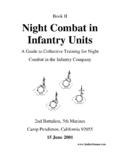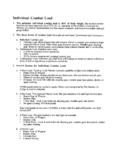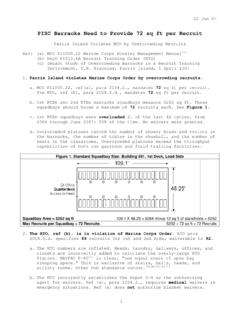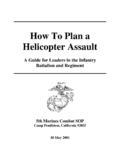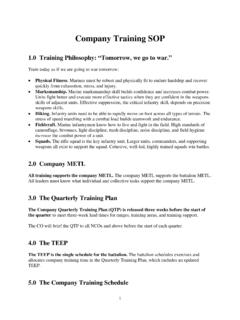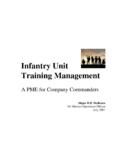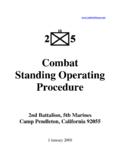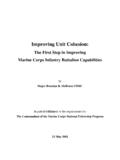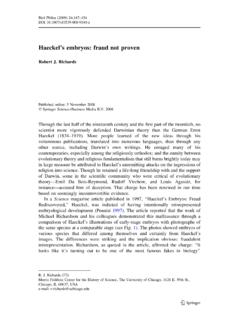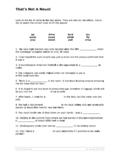Transcription of Not a Good Day to Die: The Untold Story of …
1 Notes on Afghanistan 22 March 2006 Not a Good Day to Die: The Untold Story of Afghanistan s Operation anaconda by Sean Naylor, Army Times April 18, 2005: 5:00 Presentation Discussants: Frederick W. Kagan, Military Academy at West Point Kalev Sepp, Naval Postgraduate School Moderator: Thomas Donnelly, AEI MR. DONNELLY: I would like to welcome everybody to American Enterprise Institute. My name is Tom Donnelly. I m the head of defense and national security studies here, such as that may be. Actually, today s event is a great pleasure for me in that our featured speaker is Sean Naylor, a reporter for Army Times. In my previous life, I was editor of Army Times, and indeed I hired Sean at the paper way back in 1990. I had to double-check with Sean to remember the date. But he s been a really superb writer of military affairs, particularly of the United States Army, really since even before the day I hired him. The book that he s here to tell us about the cover of which you see displayed on the screen gets two thumbs up from me.
2 I just completed reading it over the weekend. And it shows, really, every one of Sean s strengths. Particularly it s a superb piece of military reporting, as Sean will divulge and should be quite obvious. A lot of the fighting done in Afghanistan and particularly in Operation anaconda was done by America s most elite units. Again, the reporters in the audience and on the podium will understand how difficult it is to report on those communities. But it s also, really, a piece of writing that is both quite a beautifully flowing piece of writing but one that reflects Sean s long study of the United States Army. So the format is as follows. Sean will speak for about a half an hour or so. I ve asked two friends, very distinguished intellects in their own right my friend Kalev Gunner Sepp, who has a fair amount of time in Afghanistan himself; and also Fred Kagan, a professor at West Point but not for very much longer, due to join us here at AEI in the next couple of months.
3 And then there will be kind of a cross-examination by Gunner and Fred raising some issues and inviting Sean to give further comments. Then we ll open it to questions from the audience. So with that introduction, Sean, the microphone is yours, and let s get going. MR. NAYLOR: Thank you very much for that generous introduction, Tom. I m here today to talk to you about Operation anaconda . What was Operation anaconda ? It was America s first battle of the 21st century, fought in March 2002, just three years ago last month, in the remote Shahikot Valley of eastern Afghanistan. It was the largest battle fought by troops in Afghanistan; indeed, the largest battle fought by troops since Operation Desert Storm. It was also the highest-altitude battle ever fought by American soldiers. And it was the last, best opportunity to destroy much of the al Qaeda leadership and what might be termed al Qaeda s guerilla army in that part of the world. It was an opportunity that was, in part, squandered squandered not so much by the colonels and generals in Afghanistan, but by a series of decisions taken by their bosses in the Pentagon and at Central Command in Tampa, Florida.
4 Those decisions, which I shall outline here, resulted in Operation anaconda being planned and fought by a bifurcated and hopelessly confused and confusing command structure sitting on top of a force missing much of the combat power desired and requested by its commanders. But to figure out why the United States chose to wage its largest set-piece battle in a generation, a battle against its sworn enemies who were responsible for the deaths of 3,000 people in America just a few short months previously, I need to take you back to the winter of 2001-2002. 1 Notes on Afghanistan 22 March 2006 By December 2001, forces allied with the Northern Alliance had overthrown the Taliban government in Kabul. But the senior al Qaeda leaders and thousands of their troops remained in the field. However, by early 2002, senior commanders in the Pentagon and at Central Command were behaving as if the war was all but over. This was odd, given that it was al Qaeda, not the Taliban that had declared war against the United States and so recently killed 3,000 people on these shores.
5 The only reason we were fighting the Taliban at all was that they had refused to give up the al Qaeda members in their country when the United States had demanded them to do so. It was as if, having been brought up in an age when seizing an enemy s capital and deposing his government equated to victory, strategists failed to grasp that such measures did not signify the end of the war, even the war in the Afghan theater, against a transnational guerilla force like al Qaeda, which had no capital to seize. Indeed, one of the mistakes that commanders and their planners made was to fail to distinguish sufficiently between the war against the Taliban and the war against al Qaeda forces in Afghanistan. These two enemies were very different. The Taliban s army was ethnically based, drawn almost exclusively from the Pashtun tribes of southern and eastern Afghanistan, fighters who were steeped in the traditional Afghan codes of warfare. These traditions included changing sides, surrendering en masse, or simply departing the battlefield and returning to their farms when defeat seemed inevitable.
6 There are relatively few Custer s Last Stands in intra-Afghan warfare. By the time Special Forces and CIA operatives entered Afghanistan to link up with the Northern Alliance, the Taliban had already been significantly weakened as a military force by the withdrawal by Pakistan of its military intelligence troops who provided the Taliban with much of their tactical and operational expertise. That left the Taliban as something of a paper tiger when the combination of Special operations forces, CIA operatives, and the Northern Alliance army, all enabled by the precise lethality of and allied air power, drove south from the Hindu Kush to sweep the Taliban from the field. Al Qaeda was different. It had thousands of men under arms in Afghanistan. Indeed, the Taliban s 55th brigade, regarded as its best combat force, was in fact an al Qaeda seconded to the Taliban. Al Qaeda s fighters, drawn from the Gulf Arab states, Central Asia, and Chechnya, were professionals.
7 They were well-armed and reasonably well-trained by al Qaeda in their Afghan camps. They were also very highly motivated to fight Americans. There would be no mass surrenders for these men, and they had no homes to which to return. These fighters were willing to die for their cause. They had come to Afghanistan to learn the skills of jihad, and now the Americans had come to their very doorstep. The prospects for jihad could not be better. When Kabul fell, al Qaeda withdrew to the mountain fastnesses of eastern Afghanistan. Tora Bora is up here, the Shahikot Valley is down here. These were strongholds that the al Qaeda fighters knew well, deep in the Pashtun heartland, the residents of which had provided much of the Taliban s army, had benefited from Osama bin Laden s generosity, and whose Pashtun Wali code of conduct obliged them to shelter their guests when they sought that shelter. In short, destroying al Qaeda in this environment was always going to be a much more challenging proposition than defeating the Taliban in maneuver warfare.
8 But while some planners realized that rooting out al Qaeda from its mountain fortresses might require a different approach from that taken against the Taliban, commanders opted to stick with the same formula of locally recruited militia, Special operations forces and air power that had worked so well for them up to that point. One problem with this was that the Northern Alliance, and particularly its leadership, were too busy seizing the reins of power in Kabul and picking out the choicest villas for their pied- -terres in the capital to be bothered with the difficult, dirty job of going after al Qaeda in the mountains. The Northern Alliance men also knew that, as Tadjiks and Uzbeks, they would be viewed as an invading force in the Pashtun provinces. So the Americans were forced to recruit and train at short notice a hodge-podge of Pashtun militias for the biggest, toughest battle of the war. 2 Notes on Afghanistan 22 March 2006 The United States did have other options.
9 The maintains at great expense the 101st Airborne Division, Air Assault, a heliborne force designed to move large numbers of infantry over difficult terrain when no good road network is available. It would have been the ideal force for this fight. But other than a downsized brigade of two infantry battalions and a few helicopters, it was left on the shelf. Why? For three reasons. First, as we have seen, commanders had fallen in love with the Special operations / local militia / precision-air-power formula and did not fully understand that it wouldn t work as well against the al Qaeda forces sheltering in the mountains of eastern Afghanistan. Second, there was an obsession at Central Command and in the Pentagon with not deploying conventional forces to Afghanistan. Such an approach was viewed as one that would only repeat the mistakes made by the Soviets in their 1980s war in Afghanistan. This view seemed to see no difference between the Soviet strategy of deploying 140,000 troops into Afghanistan to wage a scorched-earth campaign whose aim was to impose an unpopular, alien, and morally bankrupt form of government on an unwilling population at the tip of a bayonet and a potential strategy of deploying perhaps another 10 to 15 thousand troops into Afghanistan to provide the combat power necessary to destroy al Qaeda, who were by no means universally loved in Afghanistan, even in the Pashtun areas.
10 Third, commanders had already switched their focus from the war in Afghanistan to preparing for the war they knew, or strongly suspected, was coming in Iraq. The 101st Airborne Division was needed for that war, and so it was not committed to Afghanistan. In its place, the Pentagon sent a downsized headquarters from 10th Mountain Division, at the time the most stretched, stressed division in the army. But what that headquarters deployed to Afghanistan from Uzbekistan in February of 2002, its planners were told that while their first mission was to destroy the al Qaeda forces that were gathering in the Shahikot Valley the operation that would become anaconda they were only allowed to use forces already in theater to do that. For all these reasons, leaders imposed an extremely tight cap on forces deployed to Afghanistan. They forbade the deployment of any artillery, traditionally the biggest killer on the battlefield, and only grudgingly allowed the deployment of a single company of eight Apache helicopters.

